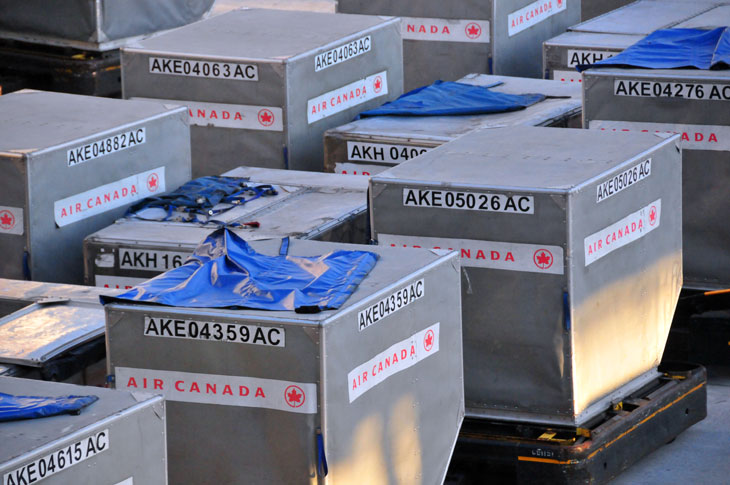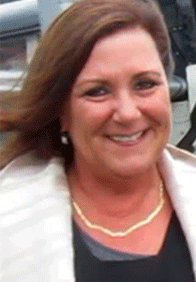IULDUG
Meet In Florida

This is the 24th annual general meeting (AGM)
of what was once known as the IULDUG, formerly an IATA interest group,
and its first AGM as a private, independent group, sans IATA. This declaration
of independence is such that IATA couldn’t even be bothered to
send a representative to the inaugural meeting, despite the fact that
the ULDUG vice chairman, Air Canada’s Urs Wiesendanger, is the
chairman of the IATA ULD Panel! The mysterious workings of this association
. . .
The meeting was very well attended, with
113 delegates consisting of 47 airlines, 59 suppliers, a combination
of various manufacturers, pooling companies, leasing companies and 7
industry guests, including FlyingTypers as exclusive media, and more
importantly the FAA and the UK CAA.
We published “Romancing
the ULD” on March 17, 2010, and a video interview with Mr.
Wiesendanger, which resonated with this group. The organization of this
meeting was exemplary; particularly when one considers that the support
staff of the nascent ULDUG consists of an army of, well, one person:
a very capable and competent woman, Louise Ladouceur. Pulling it all
together is a challenge for sure, but as evidenced by this meeting,
it is imminently doable without the fulltime meeting organizers that
other conferences routinely use, which also add cost.
A brief history is in order—SITA
first bought the Swissair ULD control system and made a deal with IATA
to jointly promote membership of the interline group. It was a win-win,
since one of the conditions of joining at the time was that carriers
have an in house tracking system, which of course SITA could offer on
a hosted basis. IATA earned a commission from every carrier that signed
up with SITA for their ULD control system; in return SITA used IATA
to run its annual ULD user group meetings, although neither SITA nor
IATA ever really exploited the ULD agreement to its full potential.
When the last truly experienced and knowledgeable
IATA secretary in this area, Ted McEvoy, left, no one at IATA realized
what they had and that SITA was paying IATA an annual, albeit modest,
commission. Additionally, IATA didn’t share these funds with the
IULDUG. IATA got out instead of getting in; it could indeed have been
a success story very much like CASS.
SITA, for whatever reasons, didn’t
make further investments in the ULD system. It ultimately resulted in
SITA cancelling the agreement and IATA subsequently lost a useful source
of revenue, but more importantly, it missed another opportunity to serve
the industry. About five years ago, the ULD system was re-launched on
a new platform, currently provided and operated by JMI of New Zealand,
now a Brambles company. JMI, a member of the ULDUG, provides ULD repair
services and its software solution naturally includes repair administration
functionality, which is a big plus.
The reason the user group elected to become
independent was summarized as the difference between IATA being airline
centric versus the group being ULD centric and, as such, dependent on
the broader logistic chain of which the airlines are but one part. To
give legitimacy and legal recognition to its stakeholders, the user
group wanted autonomy of action to manage and protect its asset –
the software system – without a trustee, to control the timing
and location of its general meetings and the ability to expand interline
ULD tracking throughout the supply chain to include non-IATA airlines,
all things the rigid IATA framework doesn’t support. It’s
a refrain we have been hearing from other groups, such as the freight
forwarders who are in a similar situation. And not surprisingly, it’s
easier said than done!
The challenges abound and start right
in their backyard, or rather the head offices of the carriers, where
the value of ULDs to the airline commands little recognition from top
management. ULDs compete with major cost factors such as fuel and crew
and as a line item on the budget pale in comparison. Yet remove the
container or pallet ready to load and transport passenger baggage or
high value cargo and all hell breaks loose! And it’s more complex
than that; ULD construction has evolved to include lightweight materials,
which make a significant contribution to saving expensive jet fuel and
reduce the emission footprint, materials engineered to absorb inflight
explosions and incorporate fire containment characteristics. It has
also expanded to include sophisticated units capable of handling the
demands of cold chain logistics based on pharmaceuticals, a six billion
dollar global business in 2009, for which 65 percent of the spend is
for air shipments, and which is projected to grow 40 percent by 2015.
A little education will have to go a long way in addressing this blind
spot.
The group currently consists of 57 member
airlines and it clearly needs to attract many more to avoid losing track
of ULDs transferred to non-members as well as build up its budget through
more members and system transactions that benefit its global scope and
ambitions. This is not trivial at a time when industry consolidation
continues—UA/CO is but one example. The IATA MITA (multilateral
interline traffic agreements) is no longer limiting the new structure
of this non-profit user group. The presence of TIACA chairman Michael
Steen as a guest speaker is a sign of the recognition and the value
this group presents, as is Mr. Steen’s commitment to have ULD
as a topic at the October 2012 Air Cargo Forum in Atlanta.
The chairman of the user group, Dick O’Mara
of UPS, and Urs Wiesendanger, his vice chairman, spared no effort in
emphasizing their interest in cooperation with IATA’s ULD Technical
Panel and their reliance on those technical standards, as well as various
airworthiness regulations and handling practices of which the user group
will steer clear. Delineation and clarity of scope were perceived as
equally important as a well-defined mission statement.
A worldwide airports survey of ULD “friendliness”
that Louise Ladouceur managed was presented at the meeting and showed
the promise and value the user group can bring to bear; based on nine
questions and a weighing system, it received input from 54 airports
and 39 airlines with a tier of top performing airports—ATL, BAH,
BOS, CEB, CMB, DFW, DUB, EWR, HEL, HKG, IKA, ICN, KIX, KUL, MXP, PEK,
PVG, THR, YYZ, YVR, ZRH—and a low scoring collection—BCN,
BKK, BOG, CDG, FCO, GRU, LHR, ORD. There was also a lot in the middle.
As evidenced by similar reports in the public domain that regularly
audit airlines’ and freight forwarders’ performance for
all to see (the Cargo 2000 monthly data summary comes to mind), such
reports can act as a powerful incentive to be at the top of the class.
It can also be the foundation for expanding the report to reflect the
performance of ground handling companies at these airports. ACI [Airports
Council International] is presently Montreal based; as is the user group
secretariat and synergy can be exploited.
Given the long standing dedication and
active support of the equipment manufacturers, there are benefits, as
represented by globally known, iconic figures such Nordisk’s Bob
Rogers and his 28 years of experience in the industry. He has authored
many of the operational guidelines aimed at ULD storage, continued airworthiness
of ULDs, ULD build-up and breakdown, ULD transportation and ULD operations
training and qualifications published in both the IATA ULD Technical
Manual and the Airport Handling Manual. The twenty or so pages replace
outdated text that took up all of five lines in previous editions. It
is hoped that IATA will be open to sharing this material with the user
group in the interest of the industry. Training when it comes to ULD
handling remains one of the major challenges and is definitely the weakest
link.
While staff performing various airline
functions that touch on aircraft require certification, whether it’s
weight and balance or flight planning, and despite the fact that in
Europe, for instance, ground handlers require licensing, this does not
extend to ULD handling despite the fact that ULDs are governed by the
same regulations and airworthiness directives as aircraft. Lack of harmonized
standards in different parts of the world contributes to more complications
for manufacturers and operators alike. Furthermore, the majority of
ground handling agreements between airlines and ground handlers do not
include ULD specific terms and conditions. This is clearly an area the
user group intends to focus on and develop proactive measures going
forward, particularly regarding ULD storage at airports, not only loading,
which enjoys some regulatory inspections.
The group has a number of important resources
going for it, such as direct participation by its members in SAE [Society
of Automobile Engineers] activities for aerospace standards and degradation
requirements in the person of Hans van Rooijen of Nordisk. One of the
panels at the meeting “Safety and Continued Airworthiness for
ULDs,” in addition to Mr. van Rooijen, featured the FAA with Kenneth
Kerzner and Joan Hughson, the UK CAA with Jason Sandever, Unitpool’s
Steve Collins and Dick O’Mara of UPS, all professionally moderated
by Bob Rogers.
A second panel later dealt with the “Proper
ULD Tracking Across the Logistic Chain,” moderated by Ian Kentfield
with Amsafe Bridport and Michael Steen, Executive VP Atlas Air; John
Stewart, VP Operations ACL Airshop; Jean-Bernard Cathala, Vice President
Swissport; James Everett, CEO JMI Aerospace; Andreas Seitz, Jettainer
and Kuehne & Nagel’s Raul Villavicencio, Manager Airfreight
Perishables. After identifying a number of obstacles, the summary offered
specific steps that will need to be taken to fulfill the mandate of
the user group, including protecting the ULDs and tracking them across
the supply chain while staying focused to deliver and build on successes.
The exchange and sharing of best practices across the board was seen
as an important goal.
Dr. William Pelletier, PHD Researcher
at the University of Florida, presented “Air Shipment of Perishable
Products,” the findings of a combined lab and field series of
tests mapping and investigating temperature variations throughout the
shipment cycle. Solar radiation was by far the greatest factor and he
recommended using reflective, breathable ULD covers for protection when
shipping perishables.
Chris Wren with Amsafe talked about ““Expect
more from your ULD” and, as a relative newcomer to the group,
put his finger of the special dynamics of the participants that he observed,
their passion and enthusiasm, which was motivating and promising. To
formalize a more open and inclusive way forward, the executive committee
would undertake to consider restructuring itself into a steering committee
with members from the manufacturers, the pooling companies, the repair
companies and ground handlers. Official feedback was expected in a January
2012 timeframe.
There’s much to do and accomplish
between now and next year’s AGM in Shanghai; stay tuned!
Ted Braun
|



